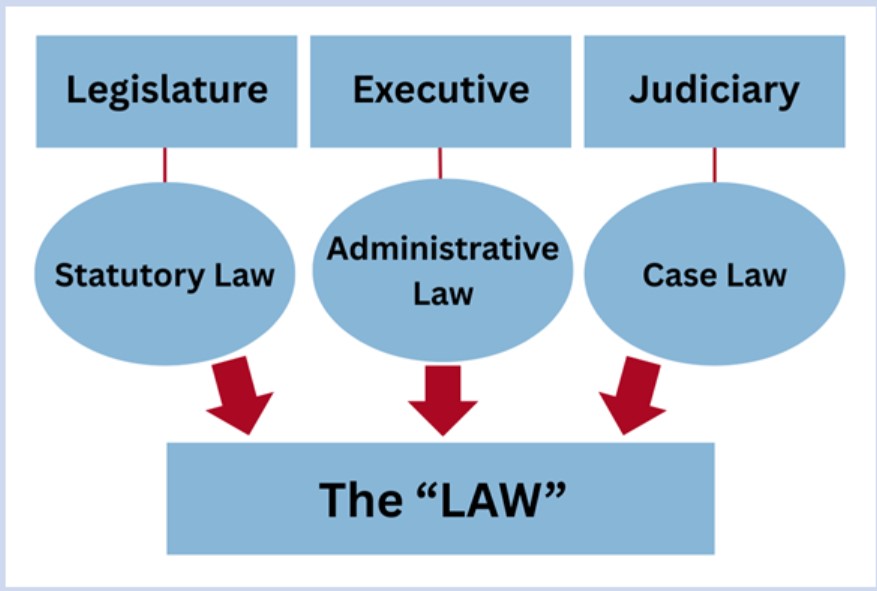We’re honored to feature an article written by Wayne Bell, former California Real Estate Commissioner. His in-depth perspective offers real value for real estate professionals—this isn’t a quick teaser, it’s a must-read full of substance. Don’t miss the opportunity to learn from one of the most respected voices in the industry.

An Easy and Fundamental California Guide for Untangling and Understanding the Terms “Law,” “Statute,” “Code,” “Regulation,” and “Common Law”
Wayne S. Bell | Former CA Real Estate Commissioner; CA Real Estate Broker; CA Lawyer; Co-Founder, Chief Advocacy Officer, and General Counsel – Real Estate Advocacy Alliance; and provider of Consulting, Advisory, and Expert Services
In meeting and speaking with people about the California Department of Real Estate (DRE), and the laws it enforces, I am sometimes baffled by the frequent misuse of one or more of the terms set forth above in the title of this brief article.
For instance, there are certain real estate licensees and others who often and inappropriately use the term “Regulation” to mean “Code” and/or “Statute.” What they refer to as a regulation is really a statutory law created by and through the California legislature and embodied in the California Business and Professions Code or some other California code.
While the following analysis and breakdown applies to California State agencies and departments generally, this piece is mainly focused on the DRE, and the laws pertaining to real estate licensees, and to the other industries which – and persons who – are overseen by the department.
Contrary to what some people inaccurately believe, the terms first above written differ in their source and scope. Quite simply, “Law” is the overarching and a broad term for the set of rules that govern conduct and dictate behavior. “Statutes” are specific laws enacted by the California legislature, while “Codes” are organized collections of statutes on a particular subject. “Regulations” are rules created by administrative agencies, like the DRE, most often to implement and clarify legislatively created statutes. And “Common Law” is law developed through court decisions and judicial precedent.
What follows is a slightly deeper dive into the specific terms (other than “law,” which is generally described above):
Statute: A statute is a formal, written law enacted by the California legislature. Statutes start as bills (Senate or Assembly), and typically declare policy, command certain actions, establish guidelines, or prohibit something. If a bill passes both houses, it goes to the Governor, who can sign the bill into law, allow it to become law without a signature, or veto the same. If the Governor vetoes the bill, the legislature can override the veto with a two-thirds vote in both houses. Most approved bills (statutes) take effect on January 1st of the following year, while urgency measures take effect immediately upon enactment.
If interested in the State’s legislative process, please see the following: https://www.senate.ca.gov/citizens-guide/legislative-process
Code: A code is a systematic collection of statutes, typically organized by subject matter. For example, the California Real Estate Law is the primary compilation of State statutes pertaining to real estate licensees. It can be found in the California Business and Professions Code, starting at section 10000. The DRE is also responsible for the enforcement of the California Subdivided Lands Law (or Act) (which governs the regulation of subdivided lands, subdivisions, and related matters), as well as the Vacation Ownership and Time-Share Act. The Subdivided Lands Law is codified in the Business and Professions Code, commencing with section 11000, and the Vacation Ownership and Time-Share Act starts at section 11210 of the Business and Professions Code.
Regulation: A regulation is a rule created by government and administrative agencies (such as the DRE) to implement, clarify, administer, and/or enforce the statutes (laws) passed by the legislature . In that regard, they are very often more detailed and specific than statutes. A look at the requirements for real estate broker supervision are instructive on this point. Business and Professions Code section 10177(h) (a statutory law), in particular, makes brokers subject to disciplinary action for failure to exercise reasonable supervision over the activities of their affiliated licensees, including both real estate salespersons and broker associates acting in a salesperson capacity. Commissioner’s Regulation section 2725 was created to further clarify and add some specificity to what constitutes reasonable supervision. Among other things, the regulation provides that reasonable supervision involves establishing policies, rules, procedures, and systems for reviewing, overseeing, inspecting, and managing various licensee activities, such as transactions, document handling, trust funds, and advertising.
Importantly, regulations cannot exceed the scope of the authority granted by the legislature. Nor can regulations vitiate or undo the validity of statutes. Crucially, California regulations are rules and standards created by State agencies and departments, which have the force of law. These regulations, along with statutes, govern a wide range of activities.
It is to be noted that regulations are often called rules or administrative laws, and they have the force of law and are legally enforceable.
The California Code of Regulations (CCR) is the official compilation of the State’s regulations. The DRE refers to its regulations as the Commissioner’s Regulations, or Regulations of the Real Estate Commissioner. They can be found in Title 10 (Investment), Chapter 6 (Real Estate Commissioner) of the CCR.
When adopting regulations, the DRE follows the procedures outlined in the California Administrative Procedure Act (APA) (Government Code section 11340, et seq.). The APA helps to ensure public participation and provides for adequate records for review by the Office of Administrative Law (OAL) (.gov) and the courts. OAL oversees the rulemaking process, ensuring regulations comply with the APA and other legal requirements. Regulations are generally adopted through “Regular” or “Emergency” processes, each with specific procedural requirements.
And please note that while “regulations” and “rules” are often used interchangeably, regulations can be thought of as more formal and specific directives issued by California governing authority. Moreover, and notably, there are many “industry rules” (and policies) that are adopted and enforced by trade groups, but they are not enforced by the government unless the same are made part of California law.
Common Law: Common law, which is also known as case law, is law developed through court decisions (rather than through statutes or regulations), including court interpretations and rulings.The imposition of a fiduciary duty on a real estate agent first arose from the common law, but many of the obligations imposed on such fiduciaries are also set forth in statutory requirements.
In essence, and in summary, the “law” is the broad and all-embracing term for the set of rules that govern conduct and regulate behavior. Statutes and regulations are written laws made by the legislature and the DRE (or another State department or agency), respectively, while common law evolves through judicial decisions. And codes are organized collections of statutes.
These sources of law interact with and influence each other, forming an engaging and dynamic governance and legal system. Understanding this system is crucial for those who are regulated by and/or interact with California State government, including the DRE.
Thank you again, Wayne Bell. Always a pleasure.
To our readers: Remember our day job is renewing or obtaining real estate and MLO licensing for people like you and your friends.www.DuaneGomer.com


No comments yet.